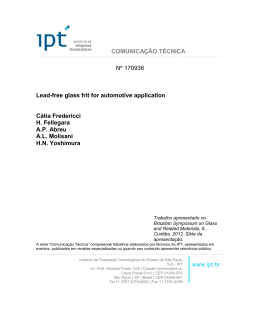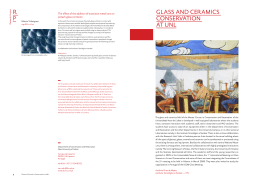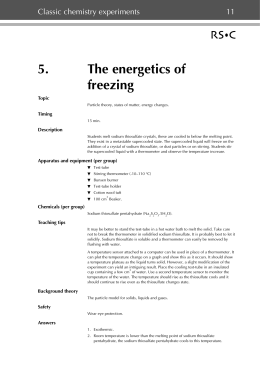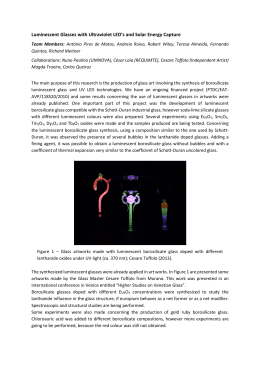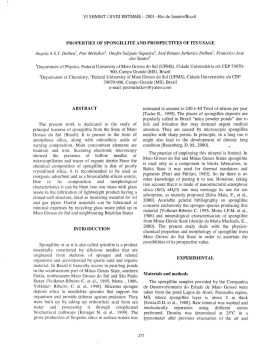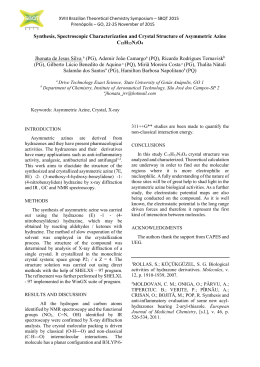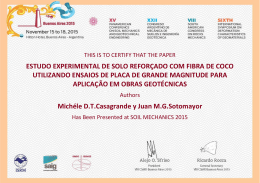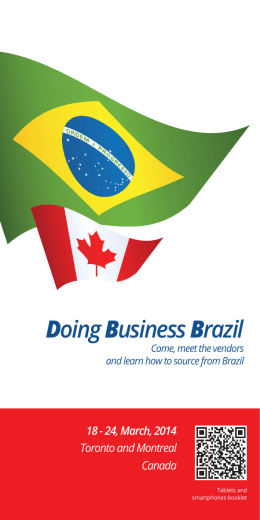Temperature control alternative technique of the glass slab during cement manipulation Técnica alternativa de controle da temperatura da placa de vidro durante a manipulação de cimentos Alcides Gonini Júnior* Sandra Mara Maciel** Regina Célia Poli-Frederico*** Sandra Kiss Moura* Murilo Baena Lopes* Introduction The null hypothesis tested was that the glass slab temperature control by means of a liquid crystal thermometer attached during cements manipulation was acceptable. For this purpose, the glass slab temperature was verified by placing a liquid crystal thermometer on the lateral surface (LAT) and under the glass slab (CEN). An infrared thermometer (IRT) was used as a gold standard to the temperature measurement at the interval of 18 oC to 24 oC. The value of each measurement in oC was recorded on 15 reference points marked on the glass slab and were repeated three times. The data was submitted to t-test (α = 0.05). The mean temperature recorded was 2.17 oC higher for the LAT and 0.48 oC for the CEN compared to the IRT. The differences showed statistical significance (p < 0.05). The null hypothesis must be accepted, as the liquid crystal thermometer placed below the glass slab provided a more accurate recording of the temperature. It is concluded that the technique is an option to the glass slab with a thermometer attached. Key words: Cementation. Dental cements. Dental prosthesis. * ** *** The energy is capable of changing the kinetic of atoms and molecules of a material. A higher temperature involves more energy. Based on this concept, chemical reactions may be accelerated or delayed due to the temperature variance. The working and setting time of some dental materials may occur due to variations on the room temperature1. The specifications established by the American Dental Association are clear concerning the importance of the temperature control during dental materials manipulation2 . The room temperature is not always controlled by the dentist, so the devices to control temperature used during manipulation may be an option3. Among all devices, to make the control of working time of luting cements easier, mainly when using zinc phosphate and glass ionomer cement, it must be the control of the glass slab temperature4-6. It was stated that the ideal room temperature to manipulate these materials should be within 18 oC and 24 oC (65 oF to 75 oF) in order to achieve their best properties7. Some researchers have suggested a technique for manipulation of zinc phosphate cements on a frozen slab8-10. According to the literature it is recommended the temperature control by means of a glass slab with thermometer attached11. However, it is seldom commercially available. Therefore, the null hypothesis of this study was that the temperature control of luting cement during its manipulation using a liquid crystal thermometer attached to a glass slab was acceptable. Disciplina Materiais Dentários, curso de Odontologia, Universidade Norte do Paraná, Londrina - PR, Brasil Disciplina Odontologia Social, curso de Odontologia, Universidade Norte do Paraná, Londrina - PR, Brasil Disciplina Genética, curso de Odontologia, Universidade Norte do Paraná, Londrina - PR, Brasil 139 RFO, v. 14, n. 2, p. 139-142, maio/agosto 2009 Materials and method A glass slab measuring 150 mm in length, 70 mm width and 20 mm thickness was used. Reference points were marked on the slab upper surface to guide the measurement. Keeping 5 mm from the borders, 15 reference points were marked, each one separated by a distance of 35 mm on the longitudinal direction and 30 mm on the transverse direction from each other (Fig. 1). Figure 3 - Image of the liquid crystal thermometer positioned below the glass slab Figure 1 - Demarcation of the reference points for the measurement of the glass slab temperature The experiment was performed at 26 ± 1 ºC in a controlled temperature room. The slab was enclosed in a plastic wrapping to avoid water condensation, placed on a refrigerator at a temperature of 6 ± 2 ºC and kept for one hour12,13. After removing the slab from the refrigerator, a tape-shaped liquid crystal thermometer (Minerva Aquarium Thermometer™, Rolf C. Hagen Corp, Montreal, Quebec, Canada) was placed laterally to its longitudinal axis (Group LAT – Fig. 2) or centrally bellow the glass slab (Group CEN – Fig. 3), using an adhesive tape. Then the slab was wiped with a dry paper towel to minimize water condensation. Readings on the liquid crystal thermometer were accomplished according to the manufacturer’s instruction, which analyzes any variation of the temperature by means of a color scale that changes o at every 1 C. A non-contacting portable thermometer (Lupa Temp™, Sentry Optromics Corp, Taipei, Taiwan) was used as a control for every single temo o perature from 18 C to 24 C indicated by the liquid crystal thermometer. An optical system of the portable thermometer collected the infrared energies from the surface of the glass slab, converting them o o in temperature value ( C or F) detecting variations o of 0.5 C (Fig. 4). This model of thermometer uses a laser scope to indicate the central point of the area to be measured. Figure 4 - Image of the non-contacting portable thermometer o The value of each measurement in C was recorded on the 15 reference points marked on the glass slab. The measures were repeated three times and the data were submitted to t-test. The level of significance was fixed at α < 0.05. Results Figure 2 - Partial view of the liquid crystal thermometer positioned laterally to the glass slab 140 For LAT group, the temperatures evaluated by the liquid crystal thermometer were always higher than those measured with the non-contacting portable thermometer, with a mean difference of 2.17 o C (Tab. 1). For CEN group, higher values were also observed but the mean difference was lower (0.48 RFO, v. 14, n. 2, p. 139-142, maio/agosto 2009 o C – Tab. 2). The differences showed statistical significance (p < 0.05) (Tab. 3). Table 1 - Mean values and differences of the temperatures in oC as measured by the non-contacting thermometer for the interval from 18 oC to 24 oC and the liquid crystal thermometer (LCT) positioned laterally to the glass slab – Group LAT Temperature on the LCT In oC 18 19 20 21 22 23 24 Arithmetic mean of the Difference of the measurements in oC temperatures in oC 15.16 16.63 17.13 18.33 19.66 21.86 23.00 Mean of the differences in oC 2.84 2.37 2.87 2.67 2.34 1.14 1.00 2.17 Table 2 - Mean values and differences of the temperatures in oC as measured by the non-contacting thermometer for the interval from 18 oC to 24 oC, with the liquid crystal thermometer (LCT) centralized below the glass slab – Group CEN Temperature Arithmetic mean of the Difference of the on the LCT measurements in oC temperatures in oC o in C 18 17.13 0.87 19 18.63 0.37 20 19.40 0.60 21 20.43 0.57 22 21.26 0.74 23 22.76 0.24 24 24.00 0.00 0.48 Mean of the differences in oC Table 3 - T test for comparing the mean differences of the temperatures between Group LAT and Group CEN in oC Temperature on Difference of the Difference of the the LCT in oC temperatures in oC temperatures in oC Group LAT Group CEN 18 2.84 0.87 19 2.37 0.37 20 2.87 0.60 21 2.67 0.57 22 2.34 0.74 23 1.14 0.24 24 1.00 0.00 Means 2.17* 0.48* *Difference of temperature between groups is statistically significant (p = 0.0001). Temperatures above 21 oC on the liquid crystal thermometer were within the recommended interval for the LAT group (Tab. 1), whereas for the CEN group, the recommended temperatures were above 19 oC (Tab. 2). In the analysis of the mean temperatures between the two groups (LAT and CEN) revealed a small variation with the use of the liquid crystal thermometer centralized below the glass slab (Tab. 3). 141 Discussion A large number of luting cements were described on the literature, as well as their different properties, applications and indications11. It is believed that the ideal manipulation technique for zinc phosphate cement comprised an adequate viscosity with enough working time, respecting the powder/ liquid ratio to achieve high mechanical resistance, low solubility and low degradation3,13. As lower the temperature during cement manipulation, as higher the working and setting times will be, favoring the maximum incorporation of powder, which allows the achievement of desired consistency and resistance3,13. It was suggested the placement of the glass slab under tap water for 5 minutes to decrease the temperature for cement manipulation6. Cooling the glass slab in the refrigerator is also mentioned as the most appropriate technique, however without indication of a standardized temperature for dental cements manipulation12. Another technique for zinc phosphate cement manipulation was suggested, consisting in frozen the slab8-10. Independent of the selected technique, it is important to ensure that the glass slab is completely free of water before manipulation of materials like zinc phosphate cement, in order to avoid the deleterious effects of water on their physical properties12. However, the results did not show significant differences between this technique and when employing a slab on temperatures above the dew point of the atmosphere. Except for one author11 who indicated control of the temperature by means of a glass slab equipped with thermometer, all the other authors3,-7,12 referenced did not suggest an alternative technique for controlling glass slab temperature. Some authors stated that techniques comprising cooling of slab for glass ionomer cement manipulation should be routinely used, due to the its positively influence on some aspects such as an adequate powder/liquid ratio, providing an adequate film thickness and extended working time4,12. Based on Tables 1 and 2, as closer as the liquid crystal thermometer is to 24 oC, small is the difference between the mean temperatures measured compared to that of the non-contacting thermometer. When the thermometer was placed laterally to the glass slab, the environmental influence was proportional to the temperatures evaluated. This effect did not occur when the thermometer was placed below the slab, due to its insulation from the environment, therefore allowing a more accurate reading of the glass slab temperature (Tab. 2). The measured temperatures between the liquid crystal thermometer centralized below the slab and the infrared digital thermometer employed as a pa- RFO, v. 14, n. 2, p. 139-142, maio/agosto 2009 rameter was quite similar, validating the crystal thermometer method (Tab. 3). Based on all authors referenced, temperature control of the slab used for zinc phosphate and glass ionomer cement manipulation is indispensable, especially when the room temperature is not ideal, and need to achieve a temperature below it. It is also noticed that some authors suggested specific temperatures or proper temperature intervals for manipulation of the mentioned materials. Except for the use of a glass slab containing a thermometer11, which displays a very wide interval of temperature scale, the authors did not suggest any means through which such control could be accomplished, transforming control of the temperature in an empirical process. Conclusions The null hypothesis must be accepted, as the liquid crystal thermometer below the glass slab provided accurate temperature. Its use is an option to the glass slab with a thermometer attached. Resumo A hipótese nula testada neste estudo foi a de que o controle de temperatura da placa de vidro com um termômetro de cristal líquido anexado durante a manipulação de cimentos seria um procedimento aceitável. Com este propósito, a temperatura da placa de vidro foi verificada posicionando-se um termômetro de cristal líquido na superfície lateral (LAT) e abaixo da placa (CEN). Um termômetro infravermelho (TIV) foi utilizado como padrão-ouro para a determinação da temperatura no intervalo de 18 oC a 24 oC. O valor de cada aferição em graus centígrados foi registrado em 15 pontos de referência marcados na placa de vidro, e as aferições foram repetidas três vezes. Os dados foram estatisticamente submetidos ao teste T (α = 0,05). A temperatura média registrada foi 2,17 oC maior no grupo LAT e 0,48 oC maior no grupo CEN em comparação ao TIV, sendo essas diferenças estatisticamente significativas (p < 0,05). A hipótese nula deve ser aceita, visto que o termômetro de cristal líquido posicionado abaixo da placa de vidro possibilitou um registro mais preciso da temperatura. Conclui-se que a técnica é uma opção para as placas de vidro com termômetro anexado. References 1. Anderson JN. Applied dental materials. 2. ed. Oxford: Blackwell Scientific Publications LTD; 1976. p. 363-70. 2. Council on Dental Research. Guide to dental materials and devices. 8. ed. Chicago: American Dental Association; 1976. p. 132-8. 3. Anusavice KJ. Phillips`s science of dental materials. 11. ed. Philadelphia: WB Saunders Company; 2003. p. 328-36. 4. Brackett WW, Vickery JM. The influence of mixing temperature and powder/liquid ratio on the film thickness of three glass-ionomer cements. Int J Prosthodont 1994; 7:13-6. 5. Bruce WL, Stevens L. Strength properties of three zinc phosphate cements mixed to two different consistencies. Aust Dent J 1989; 34:132-5. 6. Ferracane JL. Materials in dentistry – Principles and applications. 1. ed. Philadelphia: JB Lippincott Company; 1995. p. 77-84. 7. Craig RG, Powers JM. Restorative dental materials. 11. ed. St. Louis: Mosby; 2002. p. 593-634. 8. Myers CL, Drake JT, Brantley WA. A comparision of properties for zinc phosphate cements mixed on room temperature and frozen slabs. J Prosthet Dent 1978; 40:409-12. 9. Tuenge R, Siegel IA, Izutsu KT. Physical properties of zinc phosphate cement on a frozen slab. J Dent Res 1978; 57:593-6. 10. Newman SM. Frozen-slab technique for mixing zinc phosphate cement for restorations. J Prosthet Dent 1980; 43:46-9. 11. Martignoni M, Schönenberger A. Precision fixed prosthodontics: clinical and laboratory aspects. 1. ed. Chicago: Quintessence Books; 1990. p. 423-505. 12. Fricker J, Hirota K, Tamiya Y. The effects of temperature on setting of glass ionomer (polyalkenoate) cements. Aust Dent J 1991; 36:240-2. 13. Kendzior GM, Leinfelder KF, Hershey HG. The effect of cold temperature mixing on the properties of zinc phosphate cement. Angle Orthod 1976; 46:345-50. Correspondence Alcides Gonini Júnior Rua Pernambuco, 390, sala 903 86020-913 Londrina - PR Telefone: (43) 3324 7016 E-mail: [email protected] Palavras-chave: Cimentação. Cimentos dentários. Prótese dental. 142 RFO, v. 14, n. 2, p. 139-142, maio/agosto 2009
Download
